
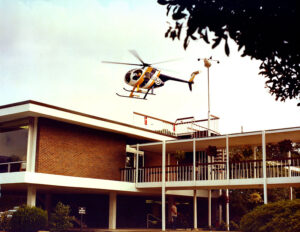 SKY 5 takes off from the WRAL helipad.
SKY 5 takes off from the WRAL helipad.
WRAL was the first station in North Carolina, and among a handful of stations in the nation, to purchase – not lease, a helicopter dedicated for news coverage. WRAL General Manager John Greene said “Live coverage is the name of the game. SKY 5 can take us to places we couldn’t cover before, and it expands our capacity to go live. That’s the main reason we bought it.”
“Look Up for SKY 5!” That was the promotion catch phrase that captivated the WRAL viewers in the summer of 1979. Look up they did! Even WRAL News anchor Charlie Gaddy was captured on camera looking up when the station ID featuring SKY 5 aired moments before the open of the 6:00 PM newscast. SKY 5 not only saturated the broadcast airwaves, it crisscrossed the sky of eastern North Carolina on a daily basis.
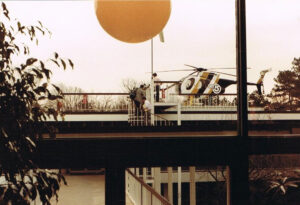 A WRAL News crew heads up to board SKY 5.
A WRAL News crew heads up to board SKY 5.
The pilot would fly SKY 5 from the airport to WRAL early in the morning and land on the helipad on top of the administration building. The sight of SKY 5 on its perch during the day, taking off and landing, was quite an attraction for commuters on Western Boulevard. The pilot had a desk in the newsroom, just like a reporter. A crew could be airborne in a matter of moments. SKY 5 would return to the airport after the evening newscast.
In selecting an appropriate helicopter, John Greene said “We wanted safety and performance.” After consulting with helicopter pilots and operators the decision was made to purchase the Hughes 500 D model helicopter. The five bladed main rotor system provided a very stable platform for a photographer to shoot steady video, plus the Hughes 500 D was fast and maneuverable. The Hughes 500 helicopter was often referred to as the “Ferrari of the skies.” After its arrival, WRAL engineer P.B. Jernigan installed the microwave unit built by Tayburn Corporation.
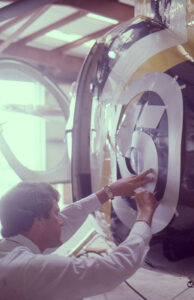 SKY 5 receives its logo from WRAL Art Director, Art Anderson.
SKY 5 receives its logo from WRAL Art Director, Art Anderson.
Many people associated the first SKY 5 with the helicopter used in the popular CBS program at the time called “Magnum PI.” The “Magnum” helicopter and SKY 5 had the same graphic “bumble bee” stripes on the fuselage. However, SKY 5 was blue thanks to Saudi Arabia. Yep, the Saudi Arabia Air Force purchased several Hughes 500 D helicopters but at the last minute scaled back their order. The helicopters that were left behind went up for sale and WRAL purchased one.
SKY 5 had two other names; N8624F is the registration number (always stays with the aircraft) and it was also named “The Birdie,” by a very young Jimmy Goodmon. In very small letters, “The Birdie” was painted above the landing light. The first SKY 5 served WRAL from 1979 to late 1984.
 A Hughes Helicopter Sale Rep shows the latest helicopter to WRAL executives John Greene and Jim Hefner.
A Hughes Helicopter Sale Rep shows the latest helicopter to WRAL executives John Greene and Jim Hefner.
The second SKY 5 was also a Hughes 500 D model and placed into service in November 1984. Roger Scott, Hughes Helicopter Sales Representative, flew a brand new Hughes 500 E model to the SKY 5 helipad for WRAL executives to look over. Since the brand new E model was still designated by the FAA as an “experimental aircraft,” it would be a few months before it could be delivered. WRAL elected to stay with a new Hughes 500 D with a few updates from the previous one. Before SKY 5 #2 arrived, it was painted WRAL Blue and White with a multi-color stripe along the tail boom, and of course received the SKY 5 logo. It sported a new microwave unit mounted on the belly of the fuselage, new avionics, and a slightly more powerful engine. It still had that new helicopter smell upon delivery. The registration number is 111OQ. This SKY 5 served the station and the public until 1999.
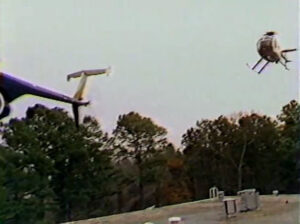 Good bye old SKY 5. Hello to new SKY 5.
Good bye old SKY 5. Hello to new SKY 5.
 SKY 5 #2 on the helipad.
SKY 5 #2 on the helipad.
To borrow a phrase from best-selling author Tom Wolfe, through the years our SKY 5 pilots possessed “the right stuff.” There have been no accidents or violations in SKY 5’s storied history.
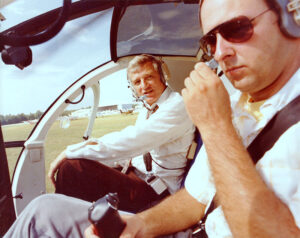 WRAL Anchor Charlie Gaddy with SKY 5 pilot Randy Watkins.
WRAL Anchor Charlie Gaddy with SKY 5 pilot Randy Watkins.
Randy Watkins was the first pilot to fly SKY 5 full time. Randy trained to fly helicopters in the US Army. He was a Warrant Officer and served 12 months in Vietnam. After Vietnam he was assigned to Fort Bragg. Watkins then received orders to go to Fort Rucker in Alabama to become an Instructor Pilot. After finishing the course, he returned to Fort Bragg as an Instructor Pilot. Watkins left the Army in 1976 and attended NCSU for two years and flew part-time in the North Carolina National Guard. In 1978, Randy left NCSU and returned to flying helicopters in commercial aviation. After ten months of flying with Air-Lift Associates in Raleigh he was offered the job to fly SKY 5.
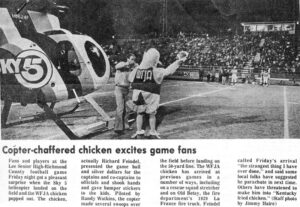 SKY 5 pilot Randy Watkins delivers the mascot to a Lee High School football game.
SKY 5 pilot Randy Watkins delivers the mascot to a Lee High School football game.
Randy safely flew news crews to many locations and provided aerials ranging from train wrecks and storm damage, to flying mascots in to sporting events. Randy left WRAL at the end of 1981 and continued his flying career in commercial aviation. Time to find another pilot.
WRAL hired veteran pilot Mike Allen in January, 1982. As a pilot, Mike brought a face, voice, and personality to SKY 5.
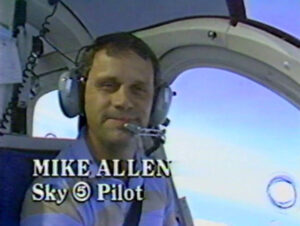 SKY 5 pilot Mike Allen
SKY 5 pilot Mike Allen
Allen served as a Captain in the US Army for six years. He completed primary flight school training for helicopters at Fort Wolters near Mineral Wells, Texas. He then went to Hunter Air Field near Savannah, Georgia to train in the UH-1 “Huey” helicopter and then advanced to Fort Benning, Georgia to fly the large Chinook helicopter. Captain Allen served in Vietnam from 1968-1969 where he earned the Bronze Star for meritorious achievement against hostile forces and earned an impressive total of 21 air medals. After Vietnam, Allen transferred to Frankfurt, Germany where he served as the officer in charge of aviation for the 3rd Armored Division Headquarters. After his tour in Germany he went to Fort Benning, Georgia for Army Career School. After six years of military service, he returned to California where he attended California State University in Bakersfield and entered into civilian aviation.
Mike flew helicopters in civilian aviation that included flying law enforcement/search and rescue for a sheriff’s department in California. He also served as Chief Pilot of a company that provides helicopters for forest fire fighting throughout the western states and he flew geological crews on expeditions to remote regions in Alaska. He continued to fly with the Army Air National Guard as well. Mike arrived at WRAL-TV in January 1982 with over 11,000 flight hours of experience under his belt.
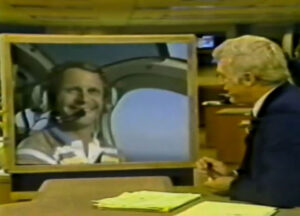 Mike Allen reporting LIVE from SKY 5.
Mike Allen reporting LIVE from SKY 5.
Mike brought a new dimension to SKY 5 by adding the role of reporter to his job as pilot. He consulted with WRAL-TV engineer PB Jernigan who fabricated a small switcher, installed a small monitor, and developed a special camera mount that could hold a camera in the floor board of the front passenger seat with a wide angle lens trained on the pilot. A news photographer operated a hand-held camera showing the news scene on the ground. Mike could switch back and forth between the camera showing him talking to the news anchor(s) and viewers, to the camera held by the photographer covering the action.
A high visibility promotion campaign quickly melded the identity of SKY 5 and Mike together. SKY 5 soared in popularity. During a recent interview for the CBC History project, Mike said, “I knew something was different when I would go to Wendy’s or McDonalds and people would say ‘Hey – you’re Mike Allen…can I have your autograph?'” Viewers “rode” along in SKY 5, not only to witness a daring rescue on the Cape Fear River, but to have fun flying low level along the North Carolina coastline or side-by-side with a vintage bi-plane. During the weather segment, the meteorologists would talk to Mike as he provided a “weather window” for viewers to see cloud formations or damage from storms.
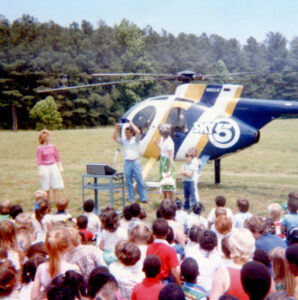 Mike Allen and SKY 5 “show and tell” at West Oxford School 1983.
Mike Allen and SKY 5 “show and tell” at West Oxford School 1983.
Many community service clubs and organizations requested Mike to be a guest speaker at their meetings. Teachers and principals often invited Mike to their schools to show students the helicopter and talk about what it is like to fly SKY 5. Mike left WRAL in early 1984 and continued his flying career before eventually entering the ministry as an ordained Presbyterian minister. Time to find another pilot.
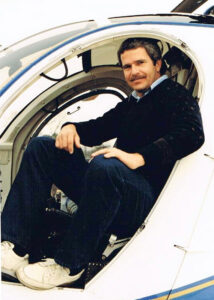 SKY 5 pilot Frank Beall becomes the 3rd pilot.
SKY 5 pilot Frank Beall becomes the 3rd pilot.
Frank Beall became the next pilot to fly SKY 5 in December, 1984. Frank flew SKY 5, version one N8624F, and would soon fly SKY 5, version two with the aircraft registration N111OQ.
Like the previous SKY 5 pilots, Frank Beall learned to fly in the US Army. He was a Captain and served in Vietnam. Beall flew a light observation helicopter (LOH), the Army version of SKY 5. Beall’s helicopter was shot down and he was wounded on June 5, 1972. He was picked up by a rescue helicopter which was shot down as well. Beall survived both crashes, but with multiple injuries. Beall earned the Distinguished Flying Cross and Purple Heart for his military service in Vietnam. After his discharge he flew in civilian aviation for many years.
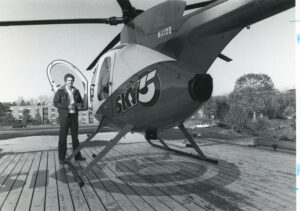 SKY 5 pilot Frank Beall.
SKY 5 pilot Frank Beall.
Frank often reported his observations from SKY 5 during the weather segment with lighthearted banter with Bob Debardelaben. He also continued to build a strong relationship with law enforcement agencies and was available for search and rescue efforts. Frank was known for being a bold pilot who put SKY 5 through its paces, but delivered some amazing images and more importantly delivered his passengers back home safe and sound.
In 1987, Frank left WRAL and headed to Florida to continue his civilian aviation career. Beall passed away in 2011 in Florida and is buried at Arlington National Cemetery in recognition of his heroic service to our nation.
In 1988, Steve Wiley became SKY 5’s fourth pilot. Steve joined WRAL while SKY 5 was still a Hughes 500D helicopter. He is still flying SKY 5, but now it is a large, comfy, fast, high tech Bell 407. Since there is so much to say about the current SKY 5 and its amazing capabilities, we’ll save that for another CapCom article.
For more videos and pictures about all of the SKY 5 helicopters, check out the CBC History website featuring SKY 5 at http://history.capitolbroadcasting.com/technology/news/sky5/ and enjoy the ride!
Thanks to Corp’s Pam Allen for this capcom story. Pam Parris Allen is a former WRAL newscast producer/director who now works as a researcher and producer on the CBC History Project.
SKY 5 takes off from the WRAL helipad.
A WRAL News crew heads up to board SKY 5.
SKY 5 receives its logo from WRAL Art Director, Art Anderson.
SKY 5 pilot Randy Watkins delivers the mascot to a Lee High School football game.
WRAL Anchor Charlie Gaddy with SKY 5 pilot Randy Watkins.
SKY 5 #2 on the helipad.
Good bye old SKY 5. Hello to new SKY 5.
A Hughes Helicopter Sale Rep shows the latest helicopter to WRAL executives John Greene and Jim Hefner.
SKY 5 pilot Mike Allen
Mike Allen reporting LIVE from SKY 5.
Mike Allen and SKY 5 “show and tell” at West Oxford School 1983.
SKY 5 pilot Frank Beall becomes the 3rd pilot.
13) SKY 5 pilot Frank Beall.